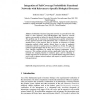Free Online Productivity Tools
i2Speak
i2Symbol
i2OCR
iTex2Img
iWeb2Print
iWeb2Shot
i2Type
iPdf2Split
iPdf2Merge
i2Bopomofo
i2Arabic
i2Style
i2Image
i2PDF
iLatex2Rtf
Sci2ools
DILS
2009
Springer
2009
Springer
Integration of Full-Coverage Probabilistic Functional Networks with Relevance to Specific Biological Processes
Probabilistic functional integrated networks are powerful tools with which to draw inferences from high-throughput data. However, network analyses are generally not tailored to specific biological functions or processes. This problem may be overcome by extracting process-specific sub-networks, but this approach discards useful information and is of limited use in poorly annotated areas of the network. Here we describe an extension to existing integration methods which exploits dataset biases in order to emphasise interactions relevant to specific processes, without loss of data. We apply the method to high-throughput data for the yeast Saccharomyces cerevisiae, using Gene Ontology annotations for ageing and telomere maintenance as test processes. The resulting networks perform significantly better than unbiased networks for assigning function to unknown genes, and for clustering to identify important sets of interactions. We conclude that this integration method can be used to enhance ...
Life Sciences | DILS 2009 | Integration Method | Specific Biological Functions | Specific Processes |
Related Content
| Added | 26 May 2010 |
| Updated | 26 May 2010 |
| Type | Conference |
| Year | 2009 |
| Where | DILS |
| Authors | Katherine James, Anil Wipat, Jennifer Hallinan |
Comments (0)

